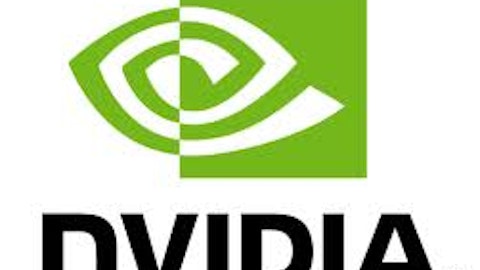This has been a long time coming for NVIDIA Corporation (NASDAQ:NVDA): “Grey” is here. The graphics specialist turned mobile powerhouse has just announced its Tegra processor with an integrated LTE baseband, which promises to intensify its competition with dominant rival QUALCOMM, Inc. (NASDAQ:QCOM).
The news comes just over a month after NVIDIA unveiled its next-generation Tegra 4 processor, previously known as “Wayne.” The new Tegra 4i with the integrated cellular connectivity has been known as “Grey” and is a major milestone in the company’s mobile ambitions.

Source: NVIDIA.
Make no mistake: this is a big deal.
There’s no “I” in Tegra — until now
The Tegra 4i uses a similar architecture to both the Tegra 4 and previous generation Tegra 3 in that there will be four primary processing cores with a fifth “companion core” for low-power tasks. However, there is a big difference in the specific cores doing the heavy lifting in each chipset.
The new Tegra 4i uses a new Cortex-A9 r4 from ARM Holdings plc (ADR) (NASDAQ:ARMH), which collaborated with NVIDIA to develop the chip. The Cortex-A9 r4 is a more power efficient version of the Cortex-A9 found in the Tegra 3, but also isn’t as powerful as the Cortex-A15 cores found in the Tegra 4.

Source: NVIDIA.
On the graphics front, the same is true. The Tegra 4i features more GPU cores than the Tegra 3 but less than the Tegra 4. NVIDIA is promising console-quality gaming at full 1,080p HD resolutions with the Tegra 4i.
Integration is key
Cellular integration has been a key differentiator for Qualcomm and a significant competitive advantage. The broader market for discrete baseband modems hasn’t been faring too well as a result. The largest buyer in the discrete baseband modem market is Apple Inc. (NASDAQ:AAPL), which buys exclusively from Qualcomm.
NVIDIA CEO Jen-Hsun Huang outlined what’s currently happening in the market on the last conference call:
You have to invest in Tegra and you have to invest in LTE in order to engage that LTE connected device market. There is no stand-alone modem business anymore and in many of these new 4G connected device marketplace, an integrated approach is necessary and that’s the reason why we bought Icera and that’s the reason why we’re investing in LTE. So that’s really one investment. You have to do it all together or you don’t do it at all. And so that’s one of the reasons why all of the stand-alone modem companies really have gotten out and that’s the reason why most of the stand-alone application processor companies have gone now. [Emphasis mine.]
That statement also has negative implications for Broadcom Corporation (NASDAQ:BRCM), which just launched a discrete LTE modem that has a chance of grabbing the Apple win from Qualcomm. Broadcom’s chip is smaller than rival offerings, which the company hopes will differentiate it from the rest. As far as Apple is concerned, a smaller die size appeals more than integrated cellular connectivity right now, since the iPhone maker uses its own A-X processors.
At the same time, Huang expressed confidence in the company’s tablet prospects, with the “vast majority” of NVIDIA’s growth coming from that form factor. NVIDIA has had more design wins in tablets than Qualcomm, including high-profile wins in the Google Inc (NASDAQ:GOOG) Nexus 7 and Microsoft Corporation (NASDAQ:MSFT) Surface RT.
We’ve only just begun
Launching an applications processor with an integrated baseband will give NVIDIA more ammo in its battle with Qualcomm. Intel Corporation (NASDAQ:INTC) has also been trying to land design wins in mobile devices, but has negligible traction thus far. However, Intel won’t achieve this level of cellular integration with its mobile processors until 2014.
NVIDIA is hoping to see Tegra 4i devices start shipping by year’s end, although the majority of gadgets probably won’t appear until early 2014. That will also be somewhat of a challenge considering the core being used in the chip. By 2014, the market will mostly be transitioned to more powerful processors so the Cortex-A9 r4 might not look as competitive in a year, especially compared to the regular Tegra 4.
Up until recently, Qualcomm has had a firm grip on both the discrete LTE baseband and integrated LTE baseband markets. Both segments will come under fire from Broadcom and NVIDIA, respectively. This competition is only now really just beginning.
The article NVIDIA Goes Grey originally appeared on Fool.com and is written by Evan Niu, CFA.
Fool contributor Evan Niu, CFA, owns shares of Apple and Qualcomm. The Motley Fool recommends Apple, Google, Intel, and NVIDIA. The Motley Fool owns shares of Apple, Google, Intel, Microsoft, and Qualcomm.
Copyright © 1995 – 2013 The Motley Fool, LLC. All rights reserved. The Motley Fool has a disclosure policy.





